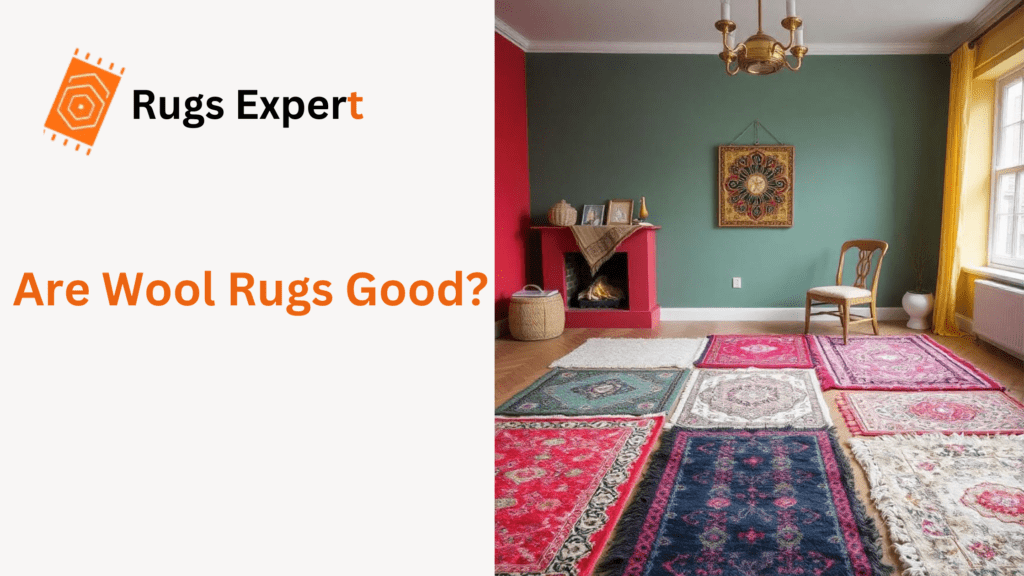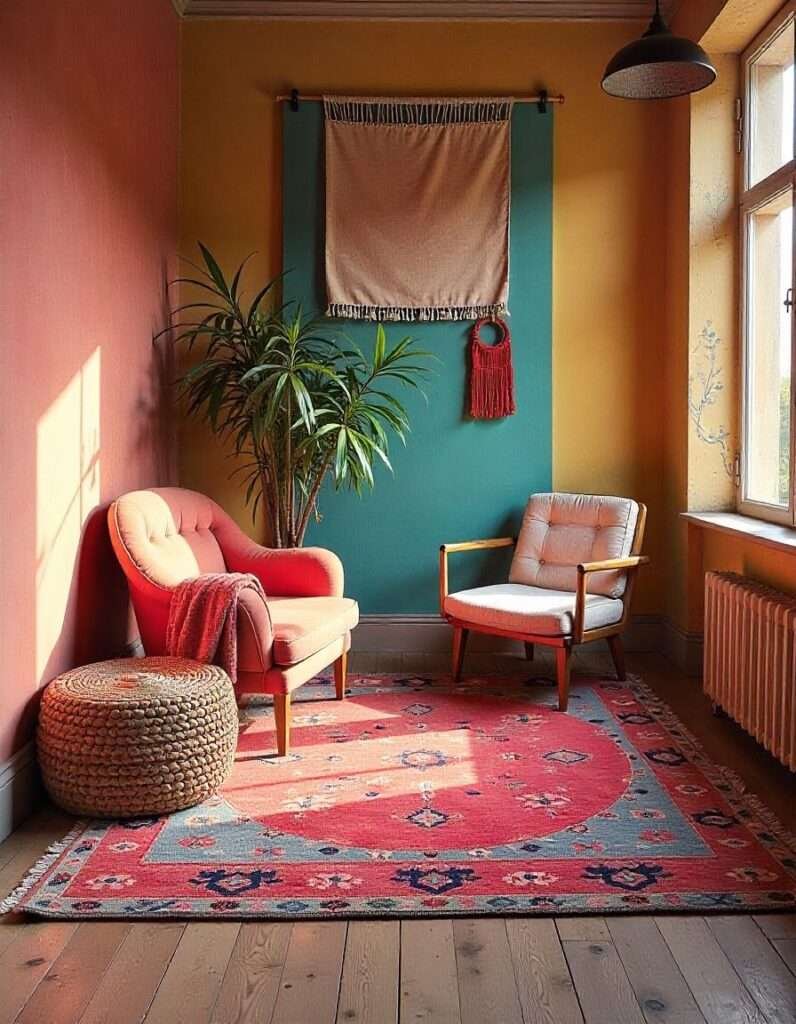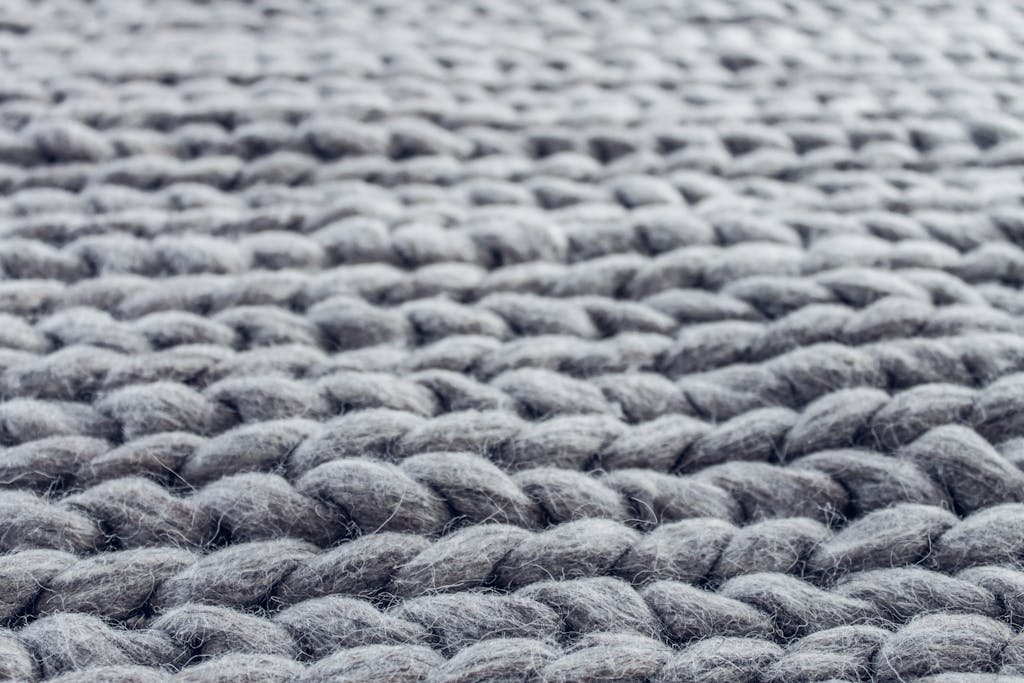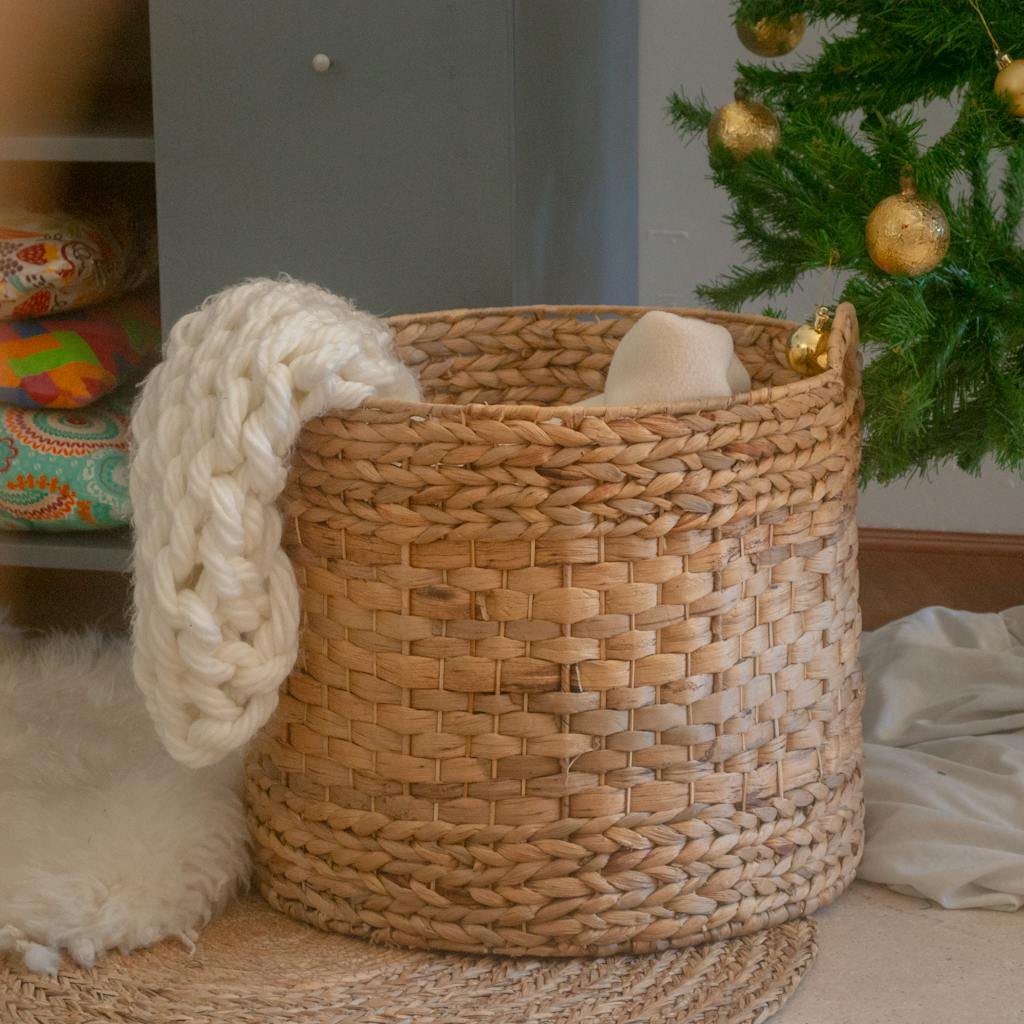
Have you ever walked barefoot on a plush wool rug and felt an instant connection with luxury and comfort? If so, you’re not alone. Wool rugs have been gracing our homes for centuries and for good reason.
The Allure of Wool Rugs: A Brief Introduction
Wool rugs have a special charm that’s hard to resist. They bring warmth and comfort to any room. These rugs have been popular for centuries. Wool is known for its softness and durability.
It comes in many colors and patterns.
Wool rugs can fit both modern and traditional homes. They’re natural and often eco-friendly.
Many people see wool rugs as a luxury item for their homes.
The Pros of Choosing Wool Rugs

Wool is the product of nature, so it has lots of benefits that can be considered before buying them. Let’s explore one by one:
Unmatched Durability and Longevity
When it comes to rugs, durability is key. After all, who wants to replace their floor coverings every few years? This is where wool rugs truly shine. Thanks to the natural resilience of wool fibers, these rugs can bear heavy foot traffic and maintain their appearance for decades.
It’s not uncommon for well-maintained wool rugs to become family heirlooms, passed down through generations. The secret lies in the structure of wool fibers. They’re naturally springy, allowing them to fluff back even after being crushed under furniture or footsteps.
This resilience means your wool rug will keep its shape and pile height much longer than synthetic alternatives. It’s like having a built-in defense mechanism against wear and tear!
Natural Insulation Properties
Have you ever noticed how sheep seem calmed by both hot and cold weather? That’s because their wool coat is an excellent insulator. And this property translates beautifully to wool rugs in our homes.
In winter, a wool rug acts like a cozy blanket for your feet, retaining warmth and making your space feel more comfortable. Come summer, it helps keep the room cooler by absorbing excess moisture from the air. This natural temperature regulation isn’t just about comfort, it can also contribute to energy savings.
By helping maintain a more stable indoor temperature, wool rugs can reduce the load on your heating and cooling systems. It’s like having a stylish, eco-friendly climate control system right under your feet!
Eco-Friendly and Sustainable
In an era where environmental awareness is more important than ever, wool rugs stand out as a sustainable choice. Wool is a renewable resource sheep are a naturally renewing material since they generate fresh wool every year.
Moreover, wool is biodegradable. Unlike synthetic rugs that may spend centuries lying in landfills, a wool rug will eventually break down without harming the environment. But the eco-friendliness of wool doesn’t stop there.
The production process for wool rugs typically requires less energy and fewer chemicals compared to synthetic alternatives. It’s like choosing a farm-to-table meal over processed food, you’re opting for a more natural, less processed product.
Inherent Stain Resistance
Let’s face it, life can be messy. Spills happen, muddy shoes make their way indoors, and sometimes, our pets have accidents. This is where wool rugs prove their worth yet again. Wool fibers have a natural protective layer that repels liquids, giving you precious extra seconds to clean up spills before they set in.
Even when stains do occur, wool’s structure makes them easier to clean. The scales on wool fibers tend to trap dirt and spills near the surface rather than allowing them to penetrate deep into the rug. It’s like having a built-in stain shield that keeps your rug looking fresh and clean with minimal effort.
Potential Drawbacks of Wool Rugs

Like everything, wool also has its pros and cons. Let’s know them:
Higher Price Point
Now, let’s address the elephant in the room, the cost. There’s no denying that wool rugs generally come with a higher price tag than their synthetic peers. This initial investment can be a significant hurdle for many homeowners.
However, it’s essential to consider this cost in the context of the rug’s lifespan. Think of it like buying a high-quality piece of furniture. While the upfront cost might be higher, a wool rug’s durability often makes it more economical in the long run.
It’s the difference between buying a cheap pair of shoes that wear out quickly and investing in a well-made pair that lasts for years.
Special Care Requirements
Wool rugs, for all their durability, do require some special attention when it comes to care and maintenance. They’re not as forgiving as some synthetic materials when it comes to harsh cleaning methods or harsh chemicals.
Also Read: How to keep Rugs Looking New?
Regular vacuuming is a must, and you’ll need to be mindful of how you clean spills and stains.
Professional cleaning is recommended every 12 to 18 months to keep your wool rug in top condition. While this might seem like a hassle, think of it as a spa day for your rug, a little pampering to keep it looking and performing its best for years to come.
Shedding and Fuzzing
New wool rugs often go through a shedding phase, which can be surprising and sometimes frustrating for new owners. This shedding is normal and temporary, typically lasting a few weeks to a few months, depending on the rug’s quality and construction.
During this time, you might notice loose fibers on the rug’s surface or even small tufts coming loose. It’s like when you get a new puppy there’s an adjustment period where you might find fur everywhere, but it settles down over time.
Wool vs. Synthetic: A Comprehensive Comparison

Let’s know the difference between wool and synthetic material.
Comfort and Feel
When it comes to comfort underfoot, wool rugs are hard to beat. The natural wrinkle in wool fibers creates tiny air pockets, resulting in a soft, springy feel that synthetic materials struggle to duplicate. It’s like the difference between walking on a cloud and walking on… well, not a cloud.
Synthetic rugs, while often softer to the touch initially, can’t match the long-term comfort of wool. Over time, synthetic fibers may flatten and lose their plushness, while wool maintains its resilient, cushiony feel.
Environmental Impact
We’ve touched on the eco-friendliness of wool, but how does it really pile up against synthetics? Most synthetic rugs are made from petroleum-based products, which are non-renewable resources.
Their production often involves more chemicals and energy, and at the end of their life, they’re not biodegradable.
Choosing a wool rug over a synthetic one is like opting for a reusable water bottle instead of a disposable plastic one. It’s a small choice that can have a significant growing impact on the environment.
Longevity and Value
While synthetic rugs might win in the short-term affordability race, wool rugs are the marathon runners of the rug world. A high-quality wool rug can last for generations with proper care, while synthetic rugs typically need replacement every 3 to 5 years in high-traffic areas.
Consider this: if you keep a wool rug for 20 years instead of replacing a synthetic rug four times in the same period, which option really offers better value? It’s about playing the long game and investing in quality that stands the test of time.
Caring for Your Wool Rug: Tips and Tricks

Care and maintenance are the keys to wool’s long life. Let’s get effective tips for their care:
Regular Maintenance
Keeping your wool rug looking its best doesn’t have to be a chore. Regular vacuuming is a key aim for at least once a week, or more in high-traffic areas. Use a vacuum with adjustable height settings and set it high enough to clean effectively without damaging the fibers.
For best results, vacuum in multiple directions to lift the pile and remove dirt from all angles. It’s like giving your rug a mini-massage, keeping it fluffy and fresh.
Dealing with Spills and Stains
Quick action is crucial when it comes to spills on your wool rug. Blot (don’t rub!) the spill immediately with a clean, white cloth to absorb as much liquid as possible. For most spills, plain water and a mild detergent solution will do the trick.
Remember, wool doesn’t like heat, so always use cold or lukewarm water. Treat your rug gently, as if you’re caring for a delicate plant nurture it, don’t overwhelm it.
Professional Cleaning
While regular home care is important, professional cleaning every 12 to 18 months will keep your wool rug in top condition. Professional cleaners have the expertise and equipment to deep clean without damaging the wool fibers.
Think of it as a yearly health checkup for your rug. It’s a beneficial step that can extend your rug’s life and keep it looking beautiful for years to come.
Wool Rug Styles and Design Options
Let’s dive into the style and designs of wool rugs:
Also Read: what are the standard rug sizes?
Traditional Patterns
Wool rugs are often linked with traditional and fancy designs. Persian and Oriental patterns, with their intricate motifs and rich colors, showcase the versatility of wool as a material. These rugs can add a touch of timeless elegance to any room, serving as a focal point or a complementary design element.
Modern and Contemporary Designs
Don’t be fooled into thinking wool rugs are only for traditional decor. Modern wool rugs come in a wide array of updated designs, from minimalist solid colors to bold geometric patterns. The natural variations in wool dyeing can create depth and interest even in simple designs.
Customization Possibilities
One of the exciting aspects of wool rugs is the potential for customization. Many manufacturers offer custom sizing and design options, allowing you to create a rug that perfectly fits your space and style. It’s like having a bespoke suit for your floor linked to your exact description.
Where to Place Wool Rugs in Your Home

Finding the right place to place your rug is as important as finding the right rug in the market full of a variety of rugs.
High-Traffic Areas
Thanks to their durability, wool rugs are excellent choices for high-traffic areas like entryways, hallways, and living rooms. They can withstand constant foot traffic while maintaining their appearance and comfort.
Bedrooms and Living Spaces
In bedrooms and living areas, wool rugs add warmth and comfort underfoot. They’re particularly pleasant in spaces where you might walk barefoot, offering a soft, cozy surface that’s a joy to sink your toes into.
Creating Cozy Reading Nooks
Wool rugs are perfect for creating inviting reading nooks or conversation areas. Their natural insulation properties make them comfortable to sit on, while their sound-absorbing qualities can help create a quiet, peaceful atmosphere.
The Investment Value of Wool Rugs
When considering a wool rug, it’s important to view it as an investment rather than just a purchase. High-quality wool rugs can appreciate in value over time, especially if they’re well-maintained.
It’s like investing in fine art or antique furniture with proper care, your wool rug could become a valuable asset.
Moreover, the longevity of wool rugs means you’re likely to save money in the long run by not having to replace your rugs as frequently. It’s a classic case of “buy nice or buy twice.” Investing in quality upfront can lead to significant savings over time.
FAQs About Wool Rugs
How long do wool rugs typically last?
With proper care, a high-quality wool rug can last for decades, even generations. It’s not uncommon for well-maintained wool rugs to be passed down as family heirlooms.
Are wool rugs suitable for people with allergies?
Generally, yes. Wool is naturally hypoallergenic and resistant to dust mites, making it a good choice for many allergy sufferers. However, some individuals may be sensitive to lanolin, a natural oil in wool, so it’s best to test for any reactions before making a purchase.
Can wool rugs be used in humid environments?
Wool rugs can perform well in humid environments due to their moisture-wicking properties. They can absorb up to 30% of their weight in moisture without feeling damp, helping to regulate humidity in a room.
How do I remove odors from a wool rug?
For mild odors, sprinkling baking soda on the rug, letting it sit overnight, and vacuuming thoroughly can be effective. For stronger odors, professional cleaning may be necessary. Avoid using harsh chemicals or steam cleaning, as these can damage the wool fibers.
Can wool rugs be used outdoors?
While wool rugs are generally designed for indoor use, some specially treated wool rugs can be used in covered outdoor areas. However, they should be protected from direct sunlight and rain, and brought indoors during severe weather conditions.
Conclusion: Are Wool Rugs Worth It?
After getting the many angles of wool rugs, we can confidently say that yes, wool rugs are indeed good and for many, they’re an excellent choice. Their durability, comfort, eco-friendliness, and timeless appeal make them a worthy investment for any home.
While they do come with a higher initial cost and require some special care, the benefits of wool rugs often outweigh these considerations. They offer a unique combination of luxury, practicality, and sustainability that’s hard to match with other materials.
Ultimately, choosing a rug is a personal decision that depends on your specific needs, preferences, and budget. But if you’re looking for a high-quality, long-lasting floor covering that offers both beauty and functionality, a wool rug is certainly worth considering.
It might just be the cozy, stylish addition your home has been waiting for!
